The Ultimate New Zealand Soccer Website | home
1966 | 1967 | 1969 | 1971 | 1972 | Anchor Dorman | Northern Steamship | Whites Aviation - 1950s | Whites Aviation - 1960s | Whites Aviation - 1970s & 1980s | Holmburn | A Diamond Day | Puriri
Puriri
Below is an extract from "The Anchor Foundry - A History", by Pat W. Win, providing a detailed history of one of my favourite ships, "Puriri".
I have tried in vain to contact Pat Win, author and copyright holder of "The Anchor Foundry - A History", to secure permission to publish the below.
If there are any objections to it appearing here, please contact me (refer the home page) and I will remove the page soonest.
"Puriri II", of 1248 gross register tons and 492 tons net, was built for the Anchor Shipping and Foundry Company by Henry Robb Ltd at the Victoria Shipyard, Leith, Scotland, being Yard Number 363 and referred to as an "A.B.4" design. Her cargo capacity was 1000 tons deadweight or 55,000 cubic feet.
While there is no documented evidence, she is said to have been designed by the Union Steam Ship Company's naval architect in Wellington. She had many features of the Union Company's postwar AC Class fleet of 3100 GRT motor vessel colliers (also built by Robb).
John Carmody, a long-serving Anchor Company marine engineer, recalled that on a bulkhead in her officers' accommodation, there was a framed draughtsman's drawing of "Puriri II" with the annotation that the funnel colours were red and black; the house colours of the Union Steamship Company of New Zealand.
Built as a replacement for MV "Puriri I", her hull was laid down in early 1948. Classified A1 at Lloyd's, she was launched on 22 July that year by Mrs E.M. Campbell, a daughter of the late W. Rogers.
On completion of sea trials, she was handed over to the Anchor Company's representative, Captain H. Norman Collins, who, after supervising her construction, was appointed master for her delivery voyage.
"Puriri II" was 212 feet 6 inches length overall, 200 feet between perpendiculars, 40 feet 10 inches beam, 39 feet moulded breadth, 13 feet moulded depth and 12 feet 7.5 inches loaded draught. Her forward hold was 47 feet long by 22 feet wide, the after hold of the same width but 42 feet long.
Her hull had a raked straight stem, a full-width upper deck with a tumble home at bridge level, bilge keels and a "streamlined rudder". The main deck had a sheer of 7 feet forward and 2 feet aft. Her hull, of mild steel, was riveted and welded.
The deck was steel with wooden decks over the accommodation and exposed decks. Hatch covers were MacGregor Patent pulling type - the sections being pulled off the hatch combings on rollers then lifted by a cargo winch to be stored vertically at the end of the hatch.
Masts were of heavy rolled mill steel plate of large diameter, doubled where necessary, while her strong derrick posts had a safe working load of 5 tons. The derrick posts also acted as exhaust ventilators for the deck accommodation. Because of the way her four cargo derrick stanchions clustered around her funnel casing, "Puriri II" was nicknamed 'The Dead Donkey'.
For cargo handling, "Puriri" had eight Clarke Chapman electric winches, all able to exert a direct pull of 4 tons, with 2.5 tons direct lift at 160 feet per minute with a light hook speed of approximately 400 feet per minute. All had a quick reverse.
Those at the forward end of the No. 1 hatch were slightly different, having barrels large enough for the heavy jumbo derrick (a single heavy lift derrick) wire rope. All were housed in separate winch houses with the controls on deck. At the stern was a Clarke Chapman capstan and, on her fo'c's'le head a windlass from the same builder to handle cables and anchors.
There were two patent stockless anchors (plus a spare), and stowed aft was an Admiralty pattern anchor for use as a stream anchor. Anchors in use were fitted with stud link chain cables 15 fathoms in length plus an extra five fathoms fitted on the port and starboard sides of the windlass next to the anchors.
Her wheel house was built of teak with a bearing compass above. The steering gear, built by Brown Bros Ltd., was electric-hydraulic - controlled from a wheel by a telemotor capable of moving the rudder through 75 degrees in 30 seconds. Radio equipment was installed in the chartroom.
She was equipped with a Walker's Trident submerged electric log which was read in the chartroom. Installed in the engine room it extended below the hull when at sea, being raised before entering port and lowered after departure. In appearance it was somewhat similar to an outboard motor shaft and propeller.
Two wooden clinker-built lifeboats constructed of larch, each to hold 21 persons, were sited in luffing davits on each side of the boat deck. The timber used for her hold ceilings - the timber lining of the holds above the double bottom tanks and the sides of the holds covering the hull structure. The seams in the lining timber were caulked by shipwrights to prevent bulk cargo material falling through the cracks - was Australian tallow wood laid on elm beams.
Built to carry bulk coal, bagged cement or general cargo (and sometimes timber), her cargo capacity was 1000 tons dead weight on a mean draught of 11 feet 9 inches or 55,000 cubic feet (1558 cubic metres) volume.
Her metacentric height - the distance between a ship's centre of gravity and centre of buoyancy; a small metacentric height creates a tender ship which rolls heavily but smoothly, while a high metacentric height creates a stiff ship which rolls heavily but jerkily - was 12 inches when loaded and her block coefficient was stated as 0.75 - the ratio of the immersed volume of the ship to that of a rectangular block of the same extreme dimensions.
When 'light ship', "Puriri" was designed to carry ballast to a total of 420 tons in double bottom, forepeak and afterpeak tanks. Light marine diesel fuel for main and auxiliary engines, also carried in double bottom tanks, was about 28 tons, plus about 6 tons in her engine room and daiuly service settling tanks.
When carrying coal she discharged her cargo using the Anchor Company's patented Reynolds-Anchor grabs.
Her speed on her trial was ten knots. This trial trip comprised four double runs at 2/3 speed to full speed over a measured nautical mile - this to average the runs both with and against the tide. A 20 minute 'Full Astern' trial was also made.
Because the Anchor Company preferred twin screw vessels for their better manoeuvrability in the difficult working conditions of the South Island West Coast ports, "Puriri II" was powered by two British Polar single-acting loop scavenging diesel engines.
These were smaller versions of the engines in the Union Company's AC Class vessels, being five cylinder engines with a cylinder diameter of 250mm and a 420mm stroke. Each engine produced 390 brake horsepower - a total of 780 BHP which, under difficult conditions, left her slightly underpowered.
Her hull and funnel casing were painted in the Anchor Company livery of black and white.
The three Ruston-Hornsby four-stroke diesel generator engines each supplied 220 Volt direct current with a continuous output of 100 kW at 600 rpm. Like all New Zealand coasters of the time she also had a shore generator.
Referred to as a motor-generator, this was plugged into a wharf box of 400 Volt AC to drive the electric motor connected to a 200 Volt DC generator, so supplying domestic power to the ship after cargo work ceased.
|
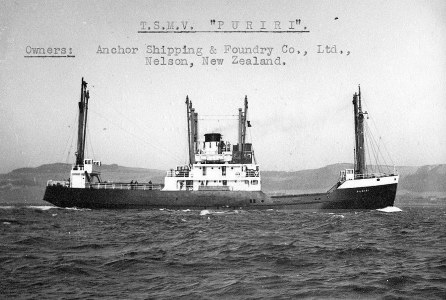 Sourced from www.photoship.co.uk -
a gorgeous profile shot of one of my all-time-favourite Onehunga visitors
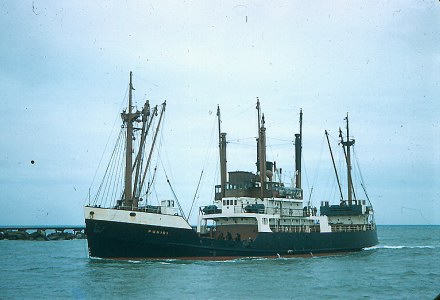 Sourced from Ships of NZ Facebook page
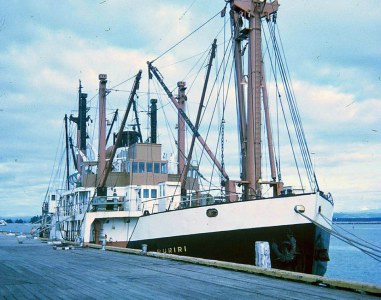 Sourced from Ships of NZ Facebook page
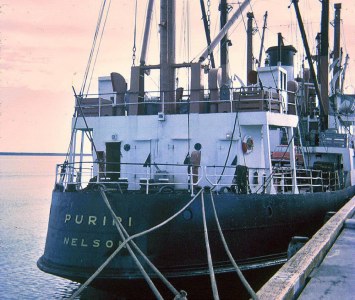 Sourced from Ships of NZ Facebook page
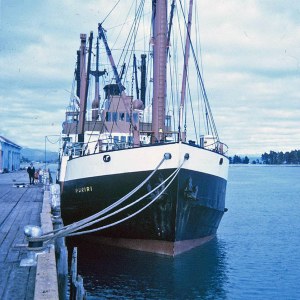 Sourced from Ships of NZ Facebook page
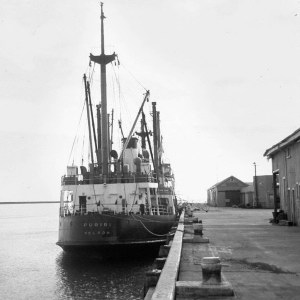 Sourced from Ships of NZ Facebook page
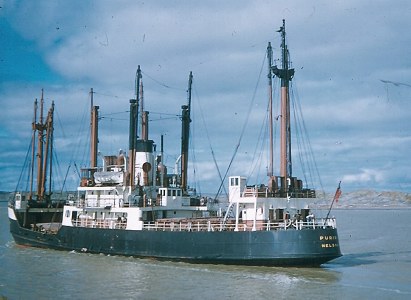 Sourced from Ships of NZ Facebook page
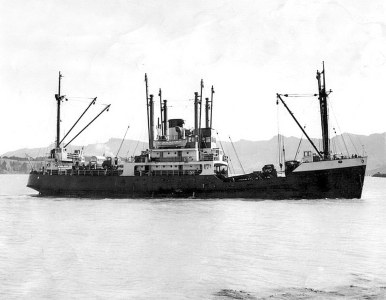 If power was required during the night for the windlass, capstan or winches, a diesel generator was started and the shore power shut down. In addition, emergency lighting was available from a large bank of lead acid batteries of a total of 112 cells having a 104 amp/hour capacity.
J.L. (Joe) Smith, an Englishman with Anchor Company connections, was appointed Chief Engineer for the delivery voyage. The 2nd Engineer was G.R. (Rip) Guy, who, after her arrival in Nelson, became the Chief. Mr Smith returned to the UK to stand by the building of MV "Mamaku", remaining with her until he was appointed the company's Marine Superintending Engineer and manager of the Anchor Foundry in 1953.
Captain Lewis R. Geen, as a junior officer in "Puriri", recalled that she had a piano in her smoking room, thought to have been purchased by Captain Norman Collins and Chief G.R. Guy.
The date of "Puriri"'s departure from Great Britain is not recorded, but she sailed with a complement of 16 officers and men from Leith to Hull, where she loaded 700 tons of Newcastle coal for New Zealand Railways.
|
En route to New Zealand she called at Gibraltar, Port Said, Port Sudan, Colombo, Singapore and Townsville for bunker fuel and stores, and after an uneventful voyage of six weeks, arrived at Wellington on 7 January 1949, then at Port Nelson at 0345 on 12 January.
The 'Nelson Evening Mail' of that date records that those who welcomed her were impressed by "the solid nature of her amidships structure"; also that she was "wide in the beam, not as long as "Rata" but can carry 1000 tons compared with "Rata"'s 980 ... Looking Spic and Span, and seaworthy dressed in new bunting, she was the centre of interest with many people visiting the port to view her".
The newspaper also commented that "Puriri" would join the company's "Kaitoa" and "Rata" in mid-February on the Nelson, West Coast ports and Onehunga service.
One of her late Masters, Lewis Geen, recalled that the vessel had spare crew accommodation and a large butcher's shop which, kept locked, had never been used. He wondered if she had been designed for use in an emergency as a minesweeper.
She was registered at Nelson (Official Number 94000), and had the unusual radio call sign, ZMWW. When her Master identified his ship, he called the much simpler version, "Puriri zed em double double yew".
Rip Guy recalled an engine room emergency when one of the Ruston diesel generator engines suddenly (and excessively) accelerated. Metal fatigue had cracked a steel fuel pipe close to the engine's air intake, allowing the fuel spraying from the crack to be drawn into the engine which caused it to rev above its governed speed. Fortunately, being close by, he was able to handle the situation, so preventing damage to the engine.
A frequent port of call was Tarakohe, in Golden Bay, to discharge coal for the Tarakohe Cement Works and load bagged cement for further destinations. Being underpowered, "Puriri"'s Master would take the precaution, as she approached the wharf, of dropping an anchor, so allowing her to swing bows onto the open bay. She was then berthed and at low tide, sat on the bottom.
Tarakohe is open to the Northwest and strong winds from that direction quickly build up a heavy sea which rolls in against the wharf. In these conditions, immediately she was afloat, "Puriri" could safely leave, using her motors when heaving in her anchor cable.
It was not uncommon for vessels which berthed bows in to have their mooring lines broken by the northwest surge. If a ship was berthed over the weekend, her crew were not permitted to return to families in Nelson. They remained aboard and instantly ready for sea - provided the tide was high enough to float the vessel.
It is unusual that the employees of Tarakohe Cement Works (who also worked as watersiders when vessels were in port) were members of the New Zealand Watersiders Union.
Pat Win's grandfather, A.J. Bastin, was the secretary of the Tarakohe Cement Workers' Union at its formation in 1920, told him that the Watersiders' Union was the only NZ union prepared to accept such a small affiliation.
Occasionally "Puriri" worked the Nelson to Onehunga general cargo run. To enter the Manukau Harbour vessels have to cross the often treacherous Manukau Bar through a shifting and uncharted channel.
When a ship arrived off the bar at night she 'stood off and on' until daylight, with her engine slow ahead, and if a twin screw vessel, with only one engine operating. At daybreak it was the responsibility of the lighthouse keeper, using a radio telephone, to talk the ship through the passage.
Before taking the bar it was the duty of the steward to ensure that all the cabin ports were closed and secured. His cabin, shared with the cook, was in the stern and, on one occasion, his failure to do this duty resulted in his own cabin being swamped when "Puriri" was heavily pooped during the crossing.
In 1960, the vessel was involved in a protracted Seaman's Union dispute. While berthed in Napier, her Master, Captain Norman Collins, was approached by a seaman who requested leave to go ashore to see a doctor about his sore back. This was granted. Eventually the man returned with a certificate stating that, with a few days of light duty, the muscle strain should disappear.
The next day the ship's sailing board was put out, stating that "Puriri" would sail for Nelson at 1.30pm. At exactly that time the season on light duties, plus an able-bodied seaman, stepped ashore to stand, arguing, on the wharf.
In the midst of this, since the rest of the crew was aboard, the ship sailed, leaving behind the two men on the wharf who then travelled to Wellington to complain to the Seaman's Union.
The first seaman, after a visit to the doctor, was declared unfit for work. The Union demanded that the Anchor Company reinstate the able-bodied seaman and reimburse both men's expenses and wages. The Company acquiesced.
However, Captain Collins refused to have the man reinstated while he was in command. The Merchant Service Guild became involved, its secretary travelling to Nelson where he upheld the Master's decision.
Subsequently, for reasons never disclosed, the Union dropped its reinstatement demand, but sought to have Captain Collins stood down for three weeks as a penalty for instructing his officers to 'cast off', stating that in April he had previously done the same while the seamen were holding a meeting.
A stalemate resulted when the Merchant Service Guild refused this demand. From the outset the Guild was prepared to go to arbitration but the Union took six weeks to agree to this.
Arbitration eventually took place, the court finding that "Puriri"'s Master was in part breach only of the Seaman's Award in that he had not endeavoured to find substitutes for the two crewmen who had stepped ashore and had been indiscreet in ordering the ship to sail while the seamen were having a meeting.
The finding stated that "to allow memories of this dispute to fade, the Master should have a month's leave and then return to his ship". Captain Collins took the leave.
This judgement was strangely at odds with an earlier arbitration in Auckland involving the Union Company's "Tofua", which had "endorsed the right of a ship's Master to select and engage his crew ... otherwise the confidence of those who go down to the sea in ships would be seriously diminished".
When the last of the Anchor Company shares were sold to the Union Steamship Company on 1 March 1972, ownership of "Puriri II" passed to that company.
Two years later, after 27 useful years on the New Zealand coast, she was sold to Maldives Shipping Ltd and renamed "Maldives Pilot". In 1975 she was sold to a Singaporean owner, Power Shipping (PLC) Ltd., which renamed her "Yellow River".
Her final owner, in 1979, was the Ya Chou Steel Manufacturing Company Ltd of Kaohsiung, China. She was then broken up.
|
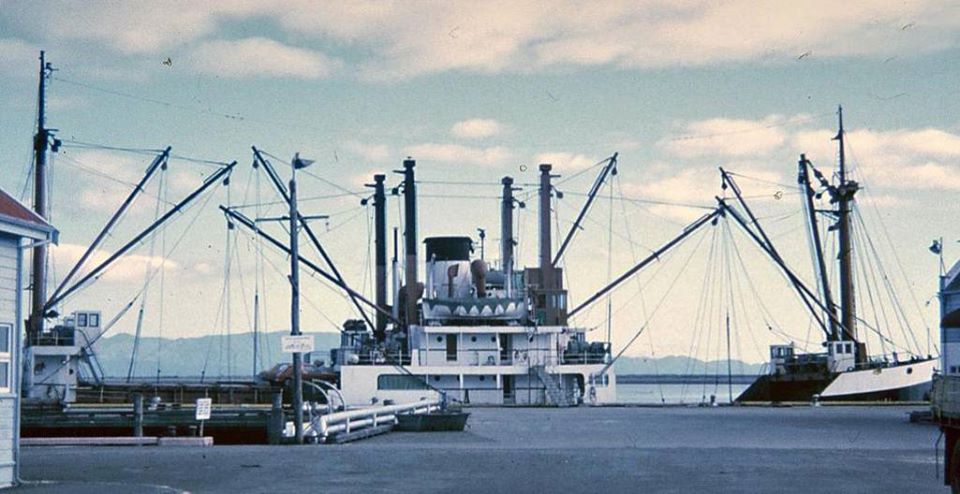
Sourced from Ships of NZ Facebook page